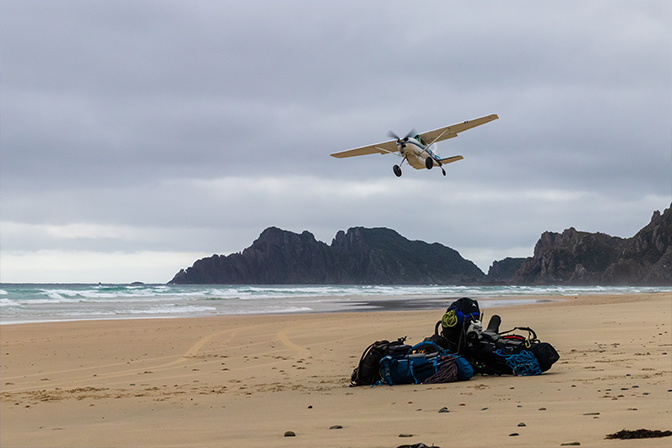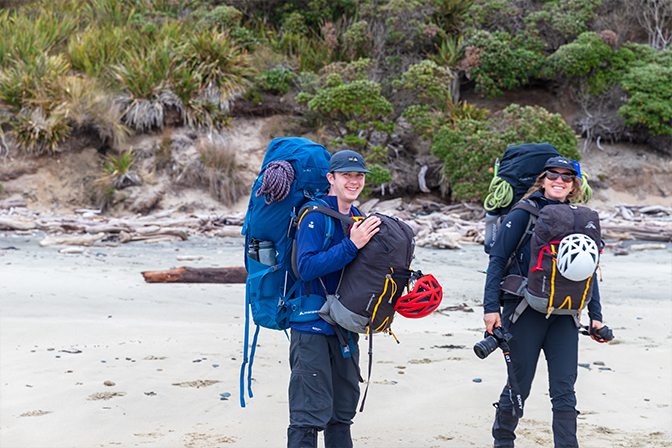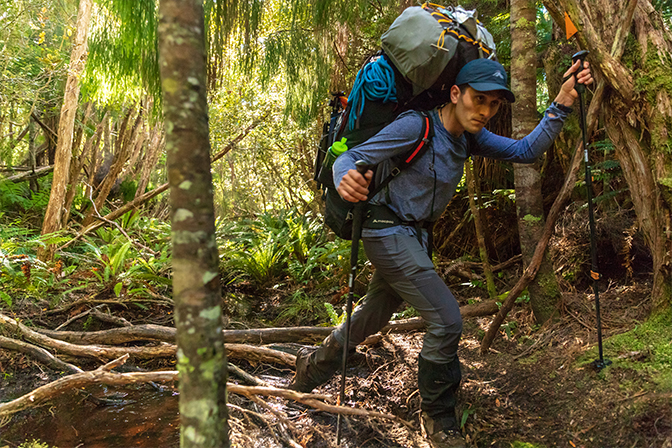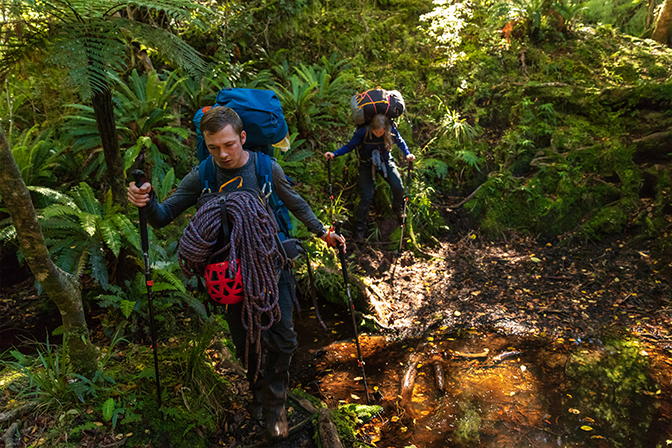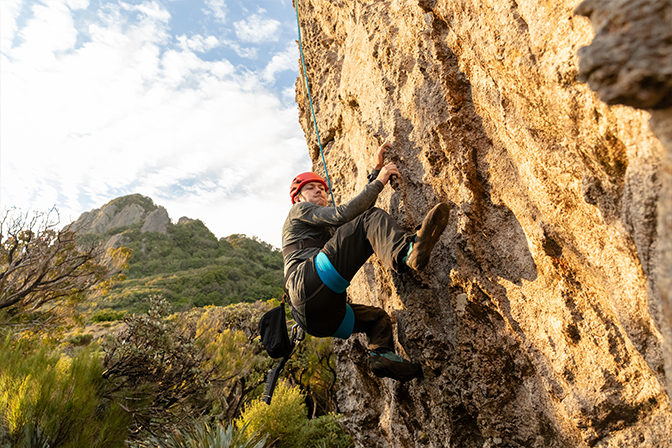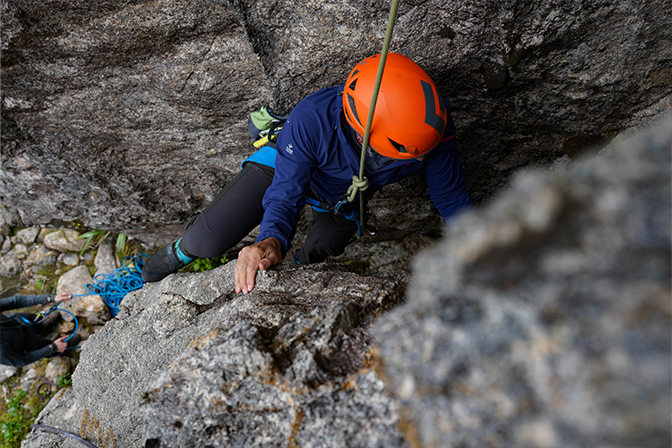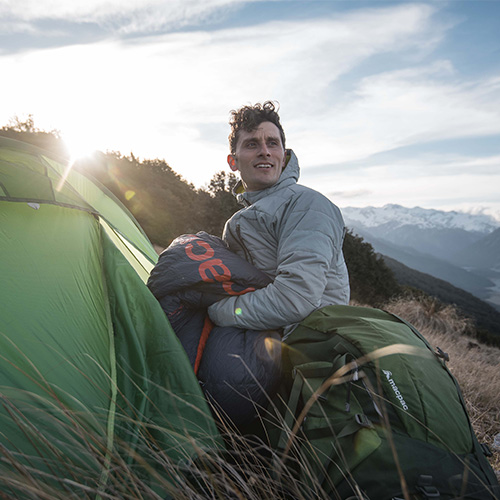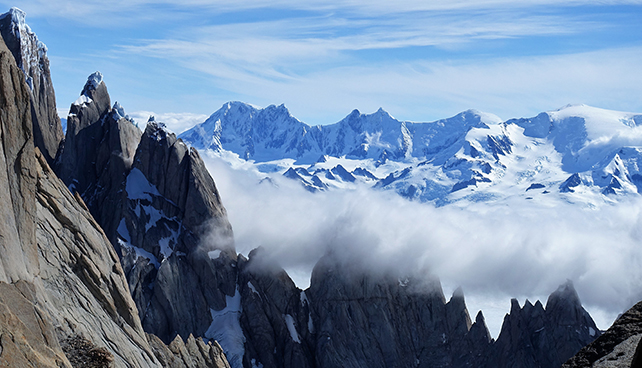
I often walked past the large panoramic image of Stewart Island’s Ruggedy Mountains, spanning a wall near one of the domestic gates at Christchurch Airport. It’s a beautiful shot: the large granite faces are blushed with warm evening sun and surrounded by dense bush that eases onto a white, surf-laced beach.
The first time I saw the photo, I stopped dead in my tracks. The rock faces beckoned, full of potential and possibility. I quickly pulled out my phone to check New Zealand’s climbing database, climbnz.org.nz: “Ruggedy Mountains: 0 Routes.” The rock was yet untouched — an exciting prospect. But the idea of heading to a remote part of New Zealand to explore unclimbed rock was intimidating. Besides, first ascents are a joy reserved for only the most elite climbers, right?
In retrospect, I only wish I had stepped out and visited Rakiura / Stewart Island sooner. Boasting astounding biodiversity and bursting with bird life, the island provides a rich and accessible experience for those who like to explore off the beaten track. It’s almost a different world, and I had no idea.
BREAKING IT DOWN
It’s a couple of years after I first saw that image at Christchurch Airport. I’d spoken to Mark, my climbing buddy, about my idea. Mark and I have significant combined experience, but we don’t climb particularly hard grades. We talked it through and decided to give it a go. At the very least, it would be a fantastic opportunity to explore the area. Looking at the photos, we were confident that there would be something, somewhere that we could climb.
Before we knew it, our small Cessna was hitting the sand on West Ruggedy Beach, a narrow and impromptu runway jammed between the dunes and the rushing surf. Mark, another friend Allie, and I were on a mission to explore one of the many virgin granite faces and outcrops that stretch for kilometers along the western side of the Ruggedy Mountains. As we bumped along the beach, it suddenly dawned on me: this was it.
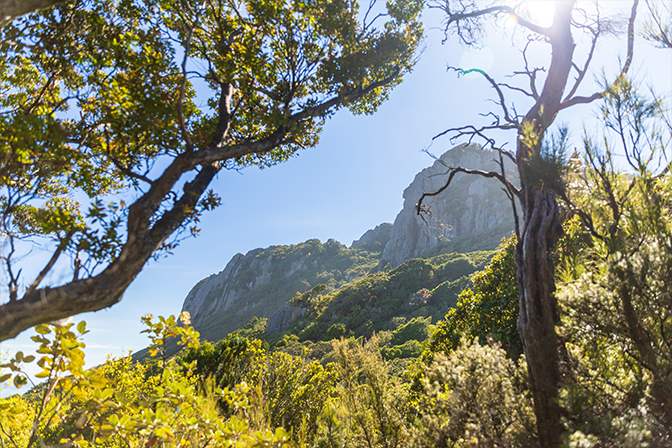
THE APPROACH
By day two of of bush bashing, our track began descending down to Waituna Bay. I dumped my pack — we were each carrying over 40kgs, and I was pleased to get rid of it. The walk up the hill had been brutal. Everything hurt. Nevertheless, I needed to focus, assess and make a plan. I looked around me.
We planned to camp here, on the saddle over which Rakiura / Stewart Island’s Northwest Circuit crossed the Ruggedy Mountains. Directly around me, the intensity of the mud was rivaled only by the density of the bush. There were no immediately useful places to camp. This came as a surprise, as we had been told that we’d quickly find a spot.
Beyond the mud and bush opened a stunning panoramic of the sea and faces. The view was as immense as it was alarming — it took my breath away. The northern faces we hoped to climb were stunning and brimming with potential. We were buzzing with excitement.
But then reality set in and I found a knot forming in my stomach. Our intel told us that the northern faces would be 50-60 metres tall — climbable in a single pitch. The wall before us was something different altogether – 90-120 metre walls stood before us, exposed and difficult to protect. While Mark and I had both climbed walls that size, we’d need to be able to bolt anchors into the rock if we were to complete a multi-pitch climb safely. We didn’t have the equipment to do this.
I’d heard that there was a lookout nearby and I hoped it would allow us to assess our situation more clearly. We found it and reached the top. While, with an unobstructed view, the northern aspects of the mountain range looked more inspiring than ever, it was also clear that we were ill-equipped for the challenge. We all went silent. The thrilled had turned to fear.
I turned around, my back to the bay, pushed aside a Manuka tree and craned to look over the saddle from which we came. That’s when I noticed a large, rocky spire — barely visible from our vantage point. I called the others and pointed it out. They immediately perked up: from the little, we could see, the rock bore potential. We set off to investigate.
The bush canopy made the rock challenging to locate. We crashed around and climbed trees, hoping for a glimpse. Eventually, we stumbled into a clearing, and there it was, a 25-metre rock spire that was much larger than we anticipated and rich with more routes than we could climb. Better yet, there was a dry area nearby, suitable for camping.
We stopped, took stock, and discussed our options. One of our primary purposes for the trip was to prove that true adventure is never far away and that an ordinary person can enjoy exploration. With this in mind, we decided that instead of pushing for the much larger northern faces, it would be better to focus our efforts on the new-found crag. We named the crag “Grey Ghost”, like the elusive Kakapo that once populated the area.

Mark looks down the route to the canopy below.
CLIMBING
Mark laughed, shook out his hands and clapped them in a cloud of chalk. It was day seven, and Mark was rapt with his new line: he’d just climbed the most challenging route yet. The previous day, Mark had spent a few hours top-roping the overhung climb. It had been tough going — he’d perform a few moves before a hold would break off, causing him to fall. Restarting the route, he would get two or three moves further than the last time, before falling again.
The climbing was excellent: the faces were well-featured and the rock-quality good, despite some patches of rot. Once the rotten holds were cleared, however, the climbing was all you’d expect from granite. Since it was difficult to protect the routes, we dropped a rope with quickdraws knotted into it every 1.5 metres or so. This allowed us to climb as if on a sports route, while also preserving the natural beauty of the area through the absence of bolts.
Next to Mark’s line was a large chimney that I’d been eyeing up. We flicked our rope of quickdraws over onto my route. I roped up and got into it. First ascents are thrilling because you don’t know what you’re going to get. I love a good chimney, and this route didn’t disappoint: the crux took a bit of figuring out but was highly enjoyable.
One of the most surprising aspects of the climb was the resonant song and sonorous booming within the chimney — the sound of a three-metre swell hammering the kelp reefs and rushing across the rocky coastline, roughly a kilometre away. Added to this was the liquid, piercing notes of more Korimako (Bellbird) than I have ever seen, mixed in with the cackling calls of Tūi and trill peep of Pīwakawaka (Fantail) feasting on the clouds of sandflies. The climb was magic.
There was a slight breeze as I finished the climb and stood on top of the crag. Bathed in the light of the afternoon sun, I was taken aback by the view. The golden sea swell curved in as it entered the bay, creating a white ribbon-wake around High Rock which sits in the channel between the bay and Codfish Island.
The Ruggedy Mountains stretched out to the left and right. The ridges and rock faces receded with distance, each separated by the misty sea spray that hung in the air and caught the afternoon light. Bird-song, golden light and wind: rarely have I felt so grounded as I did at that moment.
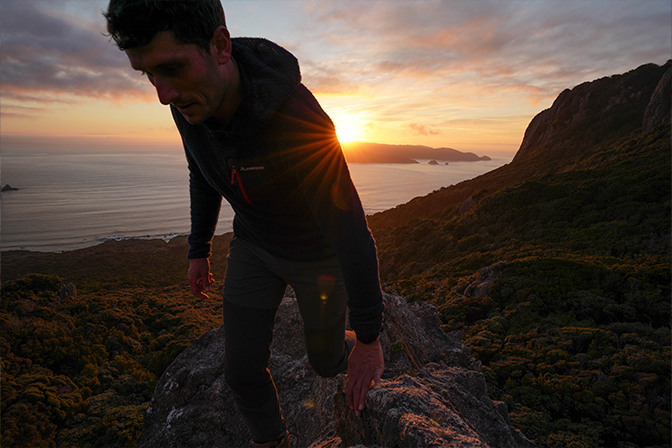
I thought of the panorama hanging on the wall at Christchurch airport, and of the times I’d placed myself into that image. Right then, standing on top of the crag, the reality was more profound and meaningful than I could have anticipated. Photos don’t capture half of it: you need to be there to enjoy the fullness of a scene.
Exploring Rakiura / Stewart Island and Grey Ghost crag exceeded every one of my expectations. Together Mark, Allie and I accomplished ten first ascents across a variety of grades, and we barely scratched the surface. There is still so much to explore and so many small and achievable crags for people to climb.
More personally, the profound beauty of the place was more significant than expected. The natural biodiversity and amount of bird life were more than I had ever seen — I even saw five Kiwis. As we left, I felt an overwhelming sense of gratitude for this.
For those who love the outdoors, there’s a simplicity of life at the crag: the singularity of focus that comes when you develop a route or area is hard to find anywhere else. Camping in the bush, waking to the birdsong, eating, climbing and resting with the sun, forms a natural, deeply satisfying primal rhythm. Adventure is never far away – especially in New Zealand – and anyone can find it if they want to.
Click here to read more about Grey Ghost Crag.
A big thanks to Macpac, Black Diamond and Goal Zero for making the trip possible.

